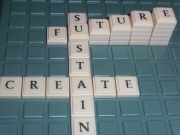Sustainable futures/Introduction
Contents
What’s it about
If we want to create a thriving and sustainable future, it’s critical to know what we’re aiming for. We need to be able to define what sustainability means within any given context as a clear and shared goal to work towards. Using a simple approach that enables you to clearly articulate the right goals and objectives, the framework then enables you to work backwards to plan the steps that will help you achieve those goals.
What will I learn?
This course is designed for people who want to learn an effective framework for creating a sustainable future where society can thrive within nature’s limits. It will enable you to:
- Learn to design projects, products and organisations that are built for lasting success and aligned with a sustainable future.
- Learn a common language and strategic planning framework which can operate across cultures and different industry sectors - the framework for Strategic Sustainable Development, or Natural Step framework.
- Evaluate current practices and reflect on how to best transform them.
- Connect with others around the world who share your passion for creating a sustainable future.
Learning outcomes
At the successful completion of this course, students will be able to:
- Describe the ecological processes that support life systems and human impacts on these
- Analyse and discuss patterns of human civilization and investigate some of the factors that contributed to their success or decline.
- Discuss the relationship between human activity and nature.
- Investigate the tipping point issues that have influenced thinking about sustainability.
- Analyse trends, issues and opportunities that will influence future activity and generations on this planet
What's Involved
You will participate in an open international online course for 10 working days (2 weeks). You will need to allocate about 1.5 to 2 hours per day for those 10 days. The course is divided into four modules that include a range of suggested learning activities.
- Sustainable Futures Micro course 1: The inspiring challenge of sustainable development. The focus is on understanding complex systems. Using a robust, yet simple, scientific foundation this module will enable the learner to explore and understand how fundamental living systems are connected, and how they are being placed under increasing pressure. This context then provides the setting for an effective strategic methodology that can enable us to imagine and create a future where our society thrives.
- Sustainable Futures Micro course 2: Designing the transition to a living future. The focus is on making sense of now and designing for the transition. Good strategy uses the tension created between two points - a current state and a desired future - to discover and agree creative ways of moving from one to the other. In this module you’ll learn some powerful tools to assess and benchmark a baseline position. The focus is on finding ways to engage others in the process that will also raise their understanding of the issues, and enable them to begin seeing opportunities of sustainable practices.
- Sustainable Futures Micro course 3: Strategic planning for success. The focus is on strategic planning - defining a vision of success. Whatever outcome you’re focused on creating - be it a building, a product or a service - great design ideas are driven by starting with the end in mind. So, defining what ultimate success looks like is fundamental to all good planning processes. In this micro course you’ll learn how to develop a clear and compelling vision that integrates a serious a smart approach to sustainable practice, and that can serve as a future reference point for setting strategy and developing creative solutions.
- Sustainable Futures Microcourse 4: Taking action and choosing priorities -yet to come. The focus is on creative solutions, prioritising actions and choosing the right support tools to achieve our vision of success.
Learners aiming for the Certificate of Achievement and/or credit towards the Certificate in Sustainable Practice and Graduate Diploma in Sustainable Practice elective will need an additional 20 hours of self directed study to complete the assessments for this course.
Prerequisites
Anyone is free to participate in this course. An internet connection and basic web browsing skills are recommended with the ability to create a blog and microblog account (instructions and self-study tutorials provided.) You are requested to keep a personal learning journal as reflection has been shown to increase learning markedly. Learners aiming to submit assessments for formal academic credit will need to meet the normal university admission requirements of the conferring institution (e.g. language proficiency and school leaving certificates). Learners aiming for the 3rd year Bachelor level are advised to have completed the majority of their 2nd year level subjects to have sufficient capability and experience for preparing assignments for 3rd year level of Bachelor study.
Assessment
Assessment is optional and done through a learning journal, blog posts and submitted work for formal credit. See a summary here
